‘Tell me where else you would put the houses’
Planning Minister Nick Champion has defended greenfield land development and called for a “more honest conversation” about public transport in the outer suburbs, as consultation begins on a new 30-year plan for Greater Adelaide.

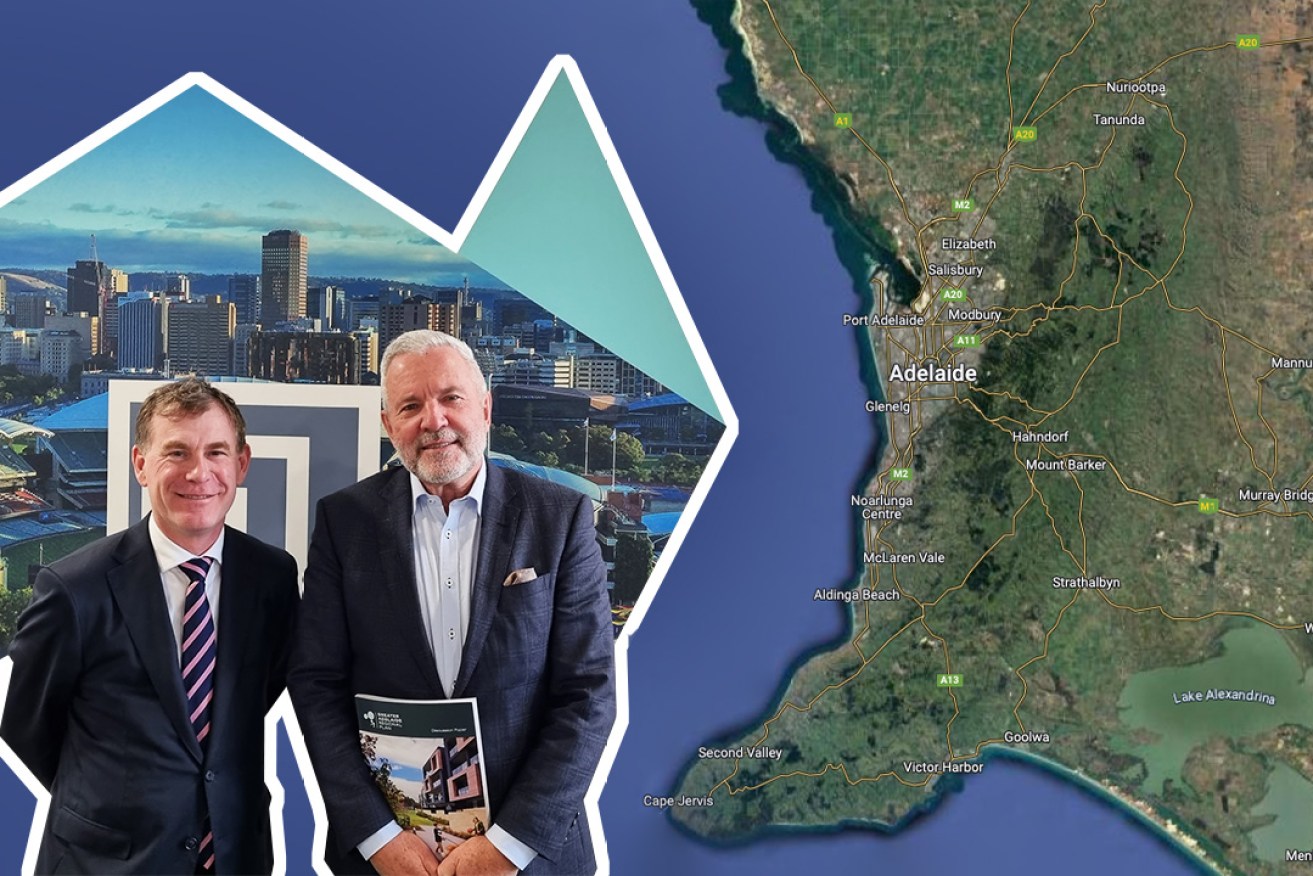
Planning Minister Nick Champion (left) and State Planning Commission chair Craig Holden. Image: Jayde Vandborg
The State Planning Commission earlier this month released a 176-page discussion paper seeking feedback on how next year’s Greater Adelaide Regional Plan should be developed, and where and how Adelaide should grow.
The final plan will represent an overarching strategic vision for Adelaide’s land use, infrastructure, transport and public realm.
At the core of this year’s discussion paper is a stated need to supply 300,000 new homes in Greater Adelaide by 2051 to account for future population growth.
The Planning Commission says there is capacity for 164,000 homes in land already zoned for housing in Greater Adelaide, and a further 47,000 homes in land identified for future rezoning.
But it says space for another 100,000 homes will need to be identified by 2051.
“Under a high growth scenario we will run out of land for future residential development within 30 years if we do not develop an ongoing rezoning program,” the discussion paper states.
“Current projections tell us there is a pipeline of land for housing and jobs for the next 15 years.
“We need to identify and investigate the 16 to 30-year opportunities for growth.”
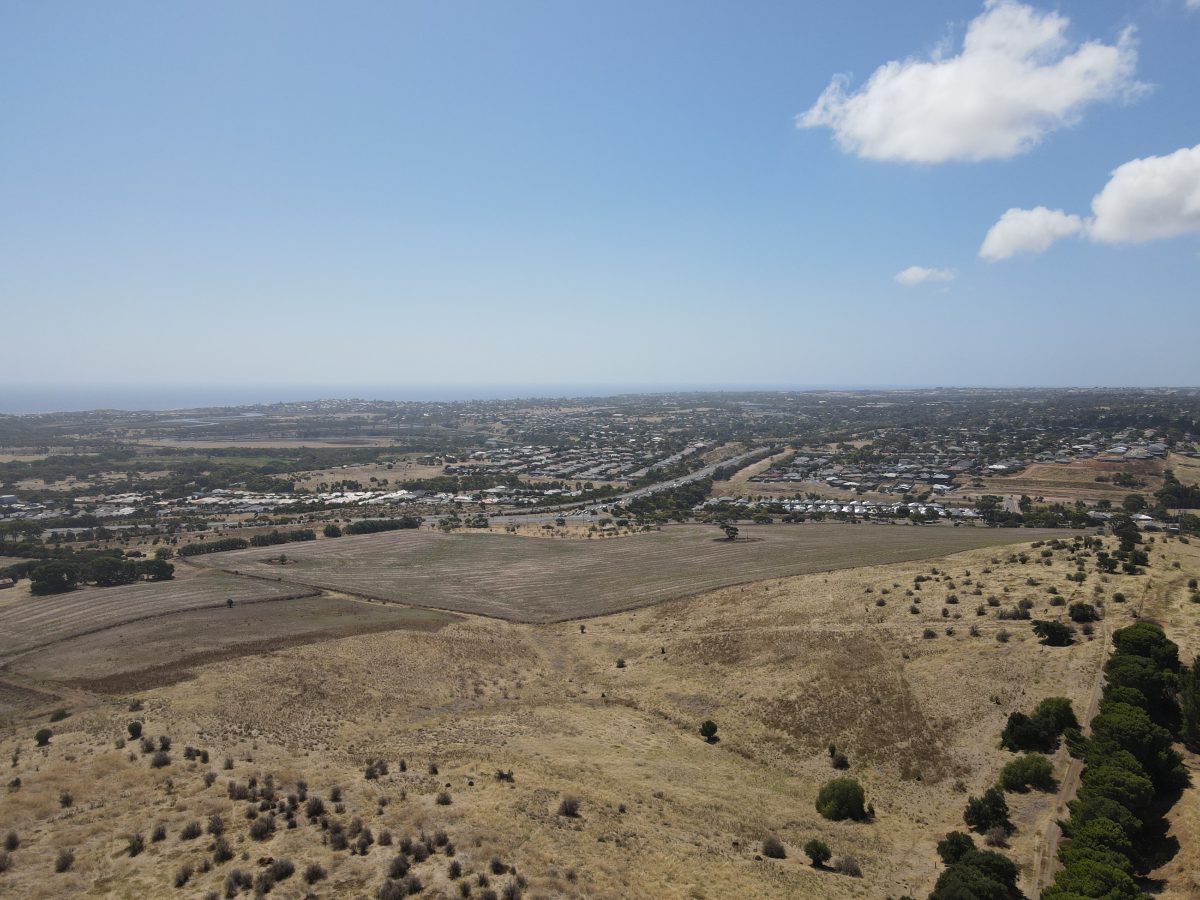
This 235 hectare plot of greenfield land in Hackham and Old Noarlunga has been earmarked for 2000 new homes as part of the Malinauskas Government’s land release program. Photo: supplied/SA Government
The 2024 plan will be the third update to the original 30-Year Plan for Greater Adelaide released in 2010.
The plans reflect both contemporary trends affecting the city’s future and the planning priorities of the government at the time.
The original plan and its 2017 update wanted Adelaide to achieve a more compact urban form and halt suburban sprawl by building new, higher density housing in existing suburbs (urban infill) rather than on vacant greenfield land.
The 2010 plan set a target for 70 per cent infill versus 30 per cent greenfield. This was revised to a more ambitious 85/15 ratio in 2017.
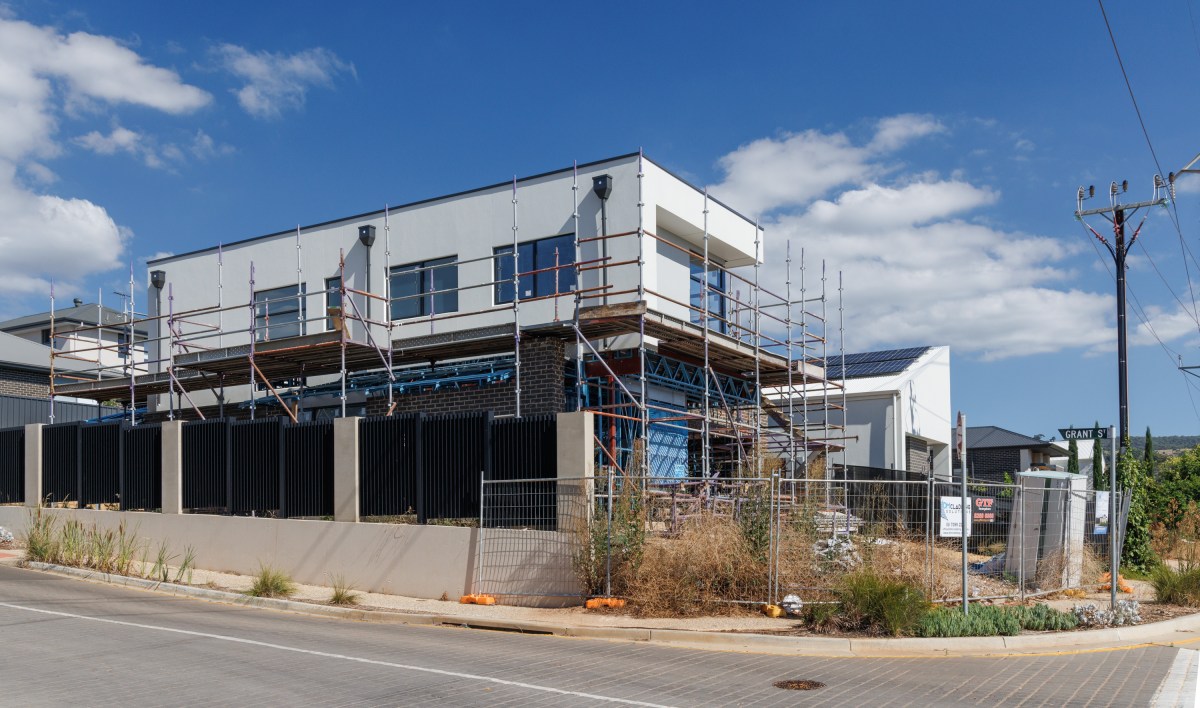
Housing subdivisions in existing suburbs were highlighted by the Planning Commission as fuelling “community concern”. Photo: Tony Lewis/InDaily
But Champion has scrapped these targets amid a broader push by the Malinauskas Government to reshape debate around urban sprawl and undertake a major land rezoning program in Adelaide’s outer suburbs.
“I think the era of targets has kind of gone by the wayside,” the minister told InDaily.
“Most other cities would give their right arm to achieve 70/30 (infill/greenfield), and we’ve achieved it all the way along.
“Melbourne’s doing the reverse. They’re doing 30/70 for the last 10 years; so, it really has been a spectacular effort by Adelaide to have that mix.
“Setting it at 85/15 was trying to engineer an outcome for a particular set of reasons, which I don’t think works.”
The Planning Commission’s discussion paper does reference the urban infill targets of the previous two plans, but highlights community concerns about infill development and says there is “sustained demand” for greenfield housing.
“High volumes of infill development in suburban areas have fuelled community concerns about design quality, amenity, tree loss and parking availability,” the paper states.
“We need a combination of greenfield, township, satellite city and infill development in the right places, with timely infrastructure provision, to provide for the needs and preferences of our current and future communities.”
This renewed focus on greenfield development has prompted criticism from planning academics, who argue urban sprawl leads to poor environmental outcomes, car-dependent suburbs and more costly developments.
Indeed, the Planning Commission’s own discussion paper notes a study by Infrastructure SA that township extensions and greenfield housing are the most costly form of land development.
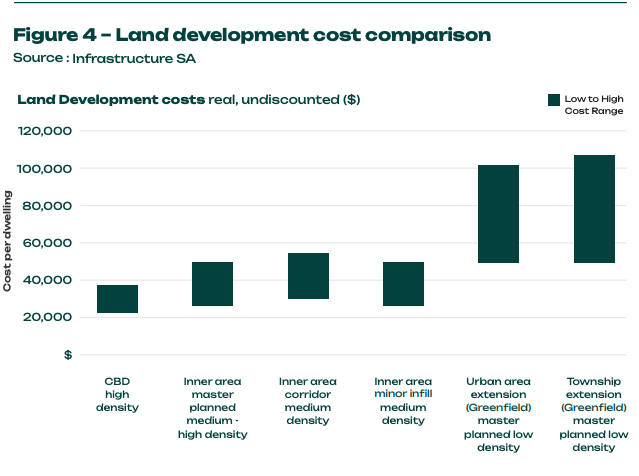
Infrastructure SA study comparing costs of infill vs greenfield development. Image: Greater Adelaide Regional Plan discussion paper
But the Planning Minister hit back at critics of greenfield development, saying there’s a “limited number of opportunities” in the inner city for new housing.
“There’s some people in the community and in the planning academia world who like to say, ‘Well (greenfield’s) not good, it’s high cost and you shouldn’t do it’,” Champion said.
“My challenge to them is to say, well you identify the area where you’re going to provide the housing.
“Don’t give me some sort of academic lecture about it… I’ve read all the same material, I understand absolutely the argument.
“But those people never ever ever say, ‘Well, we’re not going to have greenfield community 10,000 allotments X, but here’s where we should have it’ – they never tell you that bit of it.
“And the onus should be anybody who comes up and says, ‘shouldn’t have greenfield, should be 100 per cent urban infill or 85/15’, the onus is on them – you can’t just come up with some sort of magical outcome, you’ve actually got to tell me where else you would put the houses.”
The Planning Commission’s discussion paper identifies a range of proposed “areas of investigation” for greenfield and satellite city growth along Adelaide’s north-western, north-eastern, eastern and southern road networks.
The towns earmarked for investigation include Kudla and Roseworthy in Adelaide’s northeast, Murray Bridge along the South Eastern Freeway, Victor Harbor and Goolwa in the south, and areas like Two Wells along the Port Wakefield highway, near the new Buckland Park (Riverlea) township.
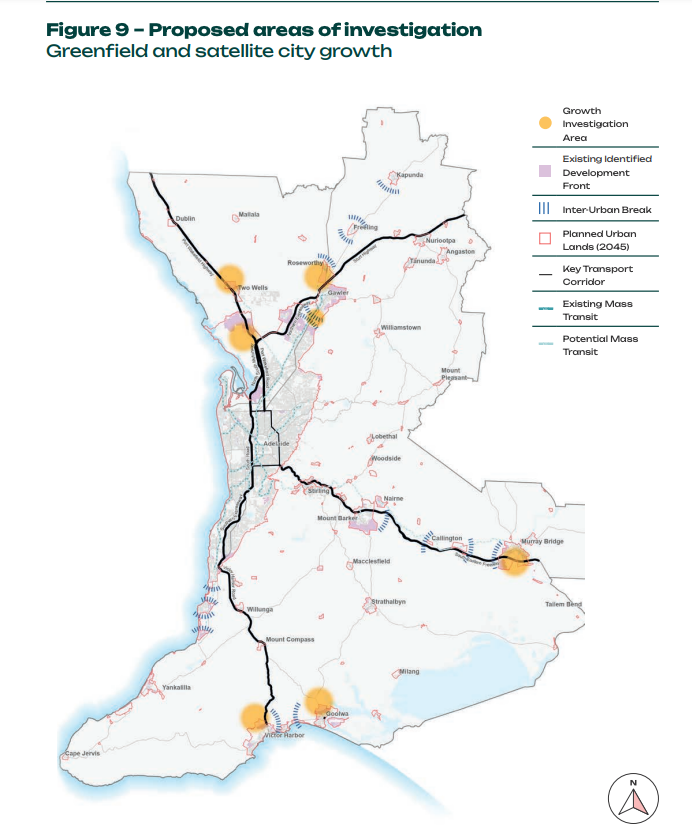
The proposed “areas of investigation” in the outer suburbs in the Greater Adelaide Regional Plan discussion paper.
Some of the investigation areas contemplate the potential for housing in Environment and Food Production Areas – a designation introduced in 2017 to protect prime food and wine regions from urban development.
The discussion paper does emphasise that the investigation areas are “larger than what we will ultimately need to meet forecast high-growth demand”.
Champion also denied that the discussion paper puts a greater emphasis on greenfield development over urban infill.
He highlighted a map within the paper that identifies opportunities in inner-city suburbs like Hindmarsh, Thebarton and Keswick for major housing developments, or “strategic infill”.
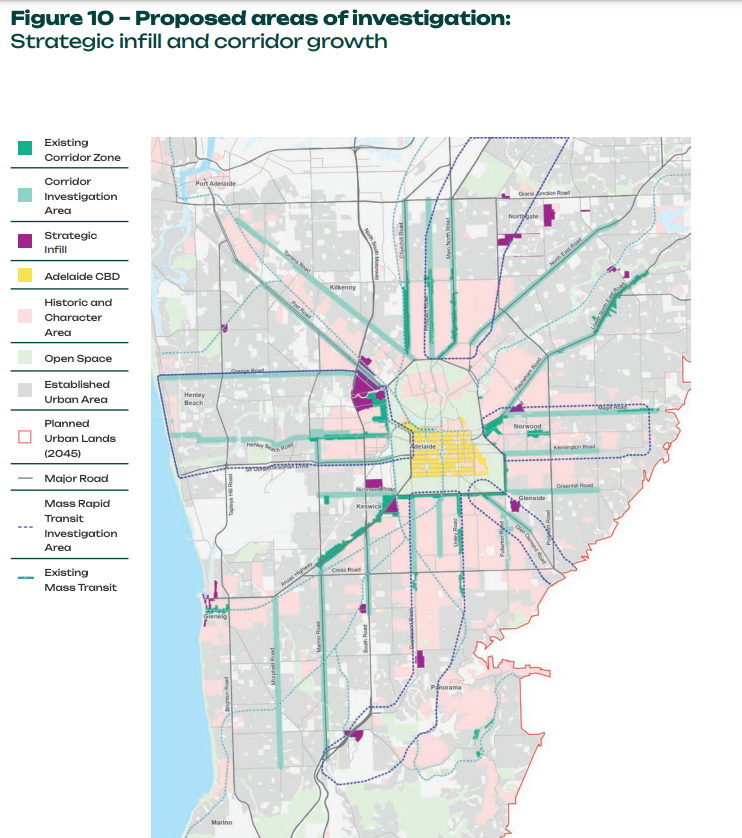
Inner-city housing development opportunities (purple) identified in the discussion paper.
“Those strategic infill opportunities often connect with public transport very easily,” Champion said.
“I think it’s a greater challenge with some of those outlying communities.”
Asked whether the plan to investigate township extensions and greenfield development in the outer suburbs would entrench car dependency, Champion said: “You’re assuming that everybody in say Concordia or Kudla is going to go to town, but they’re just as likely to work in the Barossa Valley.
“This government’s keen to have people use public transport, it’s really, really important.
“We’ve just seen the electrification of the northern line, we’re seeing the modernisation of our transport network.
“But of course, in a long linear city which stretches 11,000 square kilometres, but also because of our geography, the public transport challenge is high.”
Champion said the question of public transport would be contemplated as part of the discussion paper process.
“I think we’re just going to have to have a more honest conversation about public transport provision. I think there’s been this sort of idea that if you go out to a peri-urban community – I’ve seen this plenty of times and I’ve represented peri-urban communities federally – people say, ‘oh, well when am I getting a bus?’
“But you’ve gone out to a place which has a particular lifestyle and has a particular feature, but one of those features is… there’s some communities where it is not economical, and will never be economical, to provide public transport, and people just have to accept that.
“We don’t just want to run empty buses around, which is what happens sometimes – I’ve seen it happen.
“So, we want good efficient public transport that reaches communities, as part of this (discussion paper) that’s comprehended, but we also have to have an honest conversation about what can be rationally and economically provided to communities in the way of public transport.”
Public consultation on the discussion paper closes on November 6.




